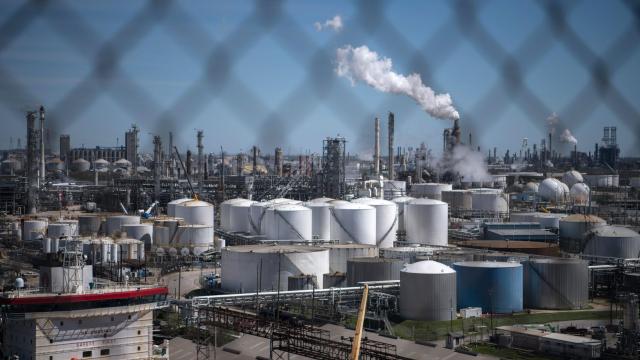After spending decades profiting off oil and gas and propagating climate denial, Exxon just needs a little money, man. In an interview with the AP published earlier this week, Joe Blommaert, the president of a division of Exxon called Low Carbon Solutions, laid out the company’s plan to transform an industrial corridor in Houston into a $US100 ($AU135) billion hub for carbon capture and storage. The company would just like a few financial backers to do it, please.
The Houston Ship Channel is one of busiest industrial stretches in the U.S. The 50-mile (80-kilometre) corridor is also home Texas’ largest cluster of oil and gas refineries; there are 10 of them in the Houston metro area alone, producing 2.6 million barrels of crude oil each day. All those refineries, which include Exxon in their ranks, produce a hell of a lot of carbon dioxide. The proposal Blommaert sketched out in this interview would capture all that carbon dioxide from the industrial facilities and inject it underground — probably, the AP reported, miles away under the Gulf of Mexico.
Carbon capture and storage (CCS) is something that the world is probably going to have to deploy as it harnesses literally every trick in the book to keep the planet from burning up. However, it’s also the oil and gas industry’s favourite climate solution for a number of reasons — chief among them is the implication that, if we could just figure out a way to somehow keep the carbon dioxide from getting in the air in the first place, all our problems with fossil fuels could be solved.
The shortcomings with CCS are plentiful in its current state. The technology has a history of high-profile (and expensive) failures and does nothing about other pollutants like methane. Some oil and gas producers also envision using all that captured carbon to help produce even more fossil fuels, which, again, is the opposite of what we need to be doing! It’s clear that this ain’t it.
A little logic won’t stop Exxon from touting the technology it has decided is a better bet than renewables. “What is important in my mind is this collaboration of the whole industry, the whole of government, and the whole of society,” Blommaert told the AP about the proposed project. “And it is actually addressing climate change, which technically is a very complicated issue. It needs all of the solutions, and it is not one or the other.”
Despite CCS’s setbacks, it’s still a darling of rich and powerful technofuturists, and the federal government has also made a lot of funds available to jumpstart the industry. Exxon, it seems, is eager to get in on some of this cash floating around — even though it’s worth hundreds of billions of dollars as a company. When the AP asked how much cash Exxon was willing to pony up for this transformative new vision for Houston, Blommaert declined to “quote a specific number” but assured the AP that “the key is that policy to attract public and private investment in supporting this is put in place. And that’s why we talk about the value of carbon, which is essential.”
Some clues as to how much Exxon could spend on this wonderland of CCS came this week in the company’s securities filings — where, for the first time, the company admitted that some of its assets may be at risk due to climate change. In those filings, which were issued under the new board members installed after a shareholder revolt in May, Exxon said it planned to spend $US15 ($20) billion total over the next five years on initiatives to reduce emissions. That’s a lot of money — more than any other oil major — but it wouldn’t come close to covering Exxon’s Houston CCS dream.
Close to the end of the interview, the reporter asked Blommaert why, if Exxon cares so much about climate change, it simply doesn’t stop producing so much dang oil and gas (great question imho). Blommaert replied that the world “will still require energy sources from fossil fuels” and that CCS “can meet the energy supplies that the world needs in a way that the emissions are being abated, and that you can do that at the lowest cost possible to society.”
Reading this interview is a fantastic exercise in familiarising yourself with Big Oil’s favourite buzzwords. Talking about the “value of carbon” is a sneaky tactic meant to create a more positive and less dire association with carbon dioxide. Blommaert’s response about “modern life” needing “energy” is lifted directly from denier groups like the Texas Public Policy Foundation. Even Blommaert’s job title is little more than a buzzword: “low carbon” is basically a nothing phrase that oil companies have started using to convince the public that they’re doing something about this whole climate change thing when what we really need is no carbon.
You’d think that one of the world’s biggest historic emitters might have a little more humility when asking for a handout for an unproven technology, but never say never.
